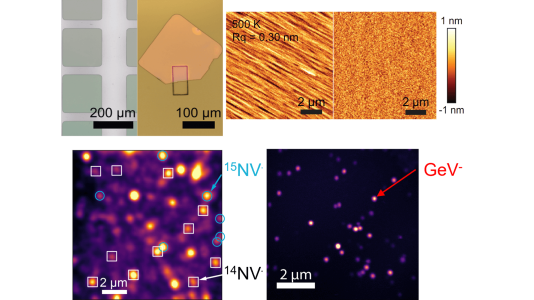
(Top-right) Side by side view of AFM characterization of the overgrown surface. (left) membrane bottom surface with etched down surface, (right) membrane top surface. Both surfaces show ~ 0.3 nm Rq roughness.
(Bottom-left) PL map of an ¹⁵N delta-doped diamond membrane highlighting delta-doped ¹⁵NV (teal circles) and naturally occurring ¹⁴NV (white circles). Membrane is 2nm thick ~30ppb ¹⁵N δ-doped layer with <1 ppb background ¹⁴N.
(Bottom-right) PL map of implantation created GeV⁻ centers in the diamond membrane from a 10⁸ cm⁻² implantation dose.
Scientific Achievement
Synthesis of high-quality tunable diamond membranes as a defect qubit host, serving as a hybrid materials platform for QIS applications.
Significance and Impact
Versatile diamond materials platform that can be integrated with nanophotonic and microelectronics devices.
Research Details
- Development of a full-stack approach for synthesizing diamond membranes while maintaining reliable material properties and integrating usable defect-based qubits.
- Generate isotopically (12C) purified diamond membranes with tunable thicknesses, bilaterally atomically flat surfaces (Rq ≤ 0.3nm), great uniformity over 200 x 200 µm scales, and bulk-like crystallinity.
- Demonstrated high quality germanium-vacancy (GeV–) centers at 5.4 K with narrow optical linewidths (125 MHz) and nitrogen-vacancy (NV–) centers at room temperature with T2* > 100 µs.
- Demonstrated this materials platform is compatible with both in-situ doping and implantation based defect creation processes.
Argonne National Laboratory seeks solutions to pressing national problems in science and technology. The nation’s first national laboratory, Argonne conducts leading-edge basic and applied scientific research in virtually every scientific discipline. Argonne researchers work closely with researchers from hundreds of companies, universities, and federal, state and municipal agencies to help them solve their specific problems, advance America’s scientific leadership and prepare the nation for a better future. With employees from more than 60 nations, Argonne is managed by UChicago Argonne, LLC for the U.S. Department of Energy’s Office of Science.
The U.S. Department of Energy’s Office of Science is the single largest supporter of basic research in the physical sciences in the United States and is working to address some of the most pressing challenges of our time. For more information, visit https://energy.gov/science.